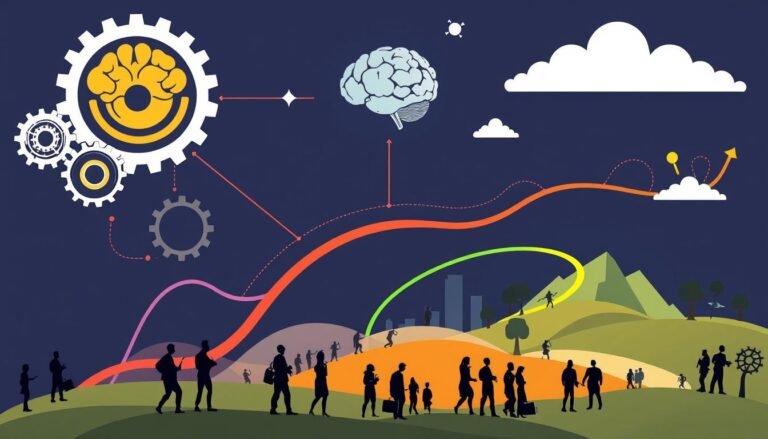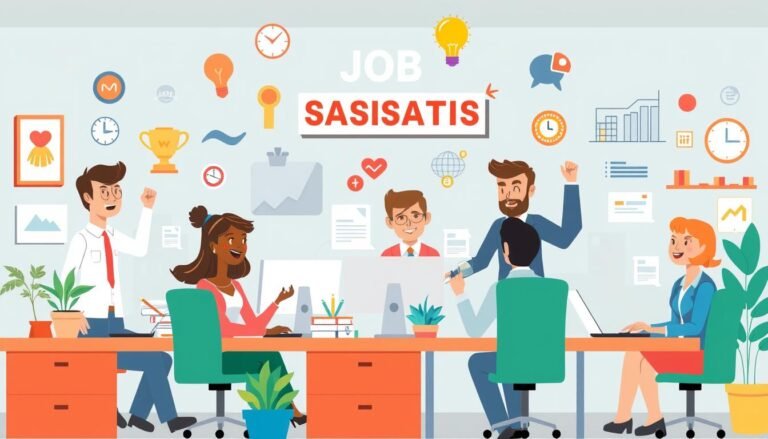How Job Stress Impacts Organizational Behavior—and What to Do About It
Is your workplace a pressure cooker ready to explode? In today’s fast-paced business world, job stress has become a silent epidemic. It affects both employees and organizations alike. As work changes quickly, the threat to worker health and company productivity grows.
Job stress is now seen as an occupational phenomenon by the World Health Organization. One-fourth of employees say their jobs are their main stressor. This trend has big consequences for how organizations behave, employee well-being, and company success.
Workplace anxiety isn’t just a personal issue—it’s a business problem. Studies show that stress-related absenteeism and reduced productivity cost U.S. companies about $300 billion a year. From decreased motivation to increased turnover rates, job stress affects every part of organizational life.
But there’s hope. By understanding the causes of workplace stress and using effective strategies, companies can make healthier work environments. These environments foster employee resilience and improve organizational performance. Let’s explore how to tackle job stress in your workplace.
Key Takeaways
- Job stress affects one-fourth of employees, impacting organizational behavior and productivity
- Workplace anxiety costs U.S. companies $300 billion annually in lost productivity
- Chronic work-related stress can lead to various health issues, from headaches to heart disease
- Implementing stress management programs and creating a supportive work culture are crucial
- Healthy stress management practices, like exercise and mindfulness, can alleviate work-related stress
Understanding Job Stress in the Modern Workplace
Job stress is a big problem in today’s fast-paced work world. As companies grow, so do the daily challenges for employees. Let’s look at the current state of workplace stress and how it affects workers.
Defining Job Stress and Its Prevalence
Job stress happens when work demands are too much for an employee. It’s a big issue, with 80% of workers saying they’re stressed at work. Over the last 30 years, stress levels have gone up by nearly 20%.
The Evolving Nature of Work and Stress
The modern workplace is always changing, bringing new stressors. For example, remote work can cause more family conflicts and lower job happiness. Small and medium-sized businesses are especially hard hit, with employees facing pay cuts, layoffs, and fewer career chances.
Common Job Stressors in Today’s Organizations
Several things cause workplace anxiety:
- Excessive workload
- Lack of control over tasks
- Poor communication
- Job insecurity
- Rapid changes in the work environment
These stressors can lead to burnout if not handled. It’s key to have good stress management and burnout prevention strategies. Companies need to focus on employee well-being to keep a healthy and productive team.
The NIOSH Approach to Job Stress
The National Institute for Occupational Safety and Health (NIOSH) sees job stress as a big problem. It affects workers in many fields. NIOSH believes that work conditions play a big part in causing stress.
NIOSH’s studies show some scary numbers. One in four workers say their job is their biggest stress. Three in four think work stress is worse now than it was before. This shows how important it is to tackle work stress.
NIOSH’s plan to prevent stress focuses on fixing work conditions. It looks at both personal and work-related factors that affect stress. By working on these, companies can make a better work culture.
“Problems at work are more strongly linked to health complaints than other stressors such as financial problems or family issues.” – St. Paul Fire and Marine Insurance Co.
To fight job stress, NIOSH suggests a few things:
- Give clear instructions to avoid confusion
- Encourage focusing on one task at a time
- Manage conflicts well
- Support regular exercise for stress relief
- Use safety software to improve health at work
By using these methods, companies can make a healthier work place. This can lead to better productivity and overall performance. NIOSH keeps researching and sharing tips to help fight job stress.
Identifying Early Warning Signs of Job Stress
Spotting stress symptoms early can greatly help employee well-being and mental health at work. Job stress shows up in many ways, impacting both people and companies.
Physical Symptoms of Job Stress
Job stress often starts with our bodies. Look out for these signs:
- Headaches or muscle tension (55% of employees)
- Stomach problems (30% of workers)
- Fatigue (70% of individuals)
- Loss of sex drive (20% of people)
Emotional and Behavioral Indicators
Stress can change how we feel and act. Keep an eye out for these signs:
- Irritability or mood swings
- Decreased job satisfaction (15% drop reported)
- Turning to alcohol or drugs (45% of workers)
- Sleep disturbances
Organizational Red Flags
Workplace stress impacts the whole team. Look for these signs:
| Red Flag | Impact |
|---|---|
| Increased overtime | 25% rise due to staff cutbacks |
| Decreased productivity | 30% improvement with regular breaks |
| High turnover rates | 40% of stress linked to layoff fears |
| Reduced team cohesion | 50% stress reduction through social activities |
Spotting these signs early lets us act fast to make work healthier. Employers can help by encouraging exercise, ensuring sleep, and creating a positive work culture.
Job Stress and Its Impact on Employee Health
Job stress has a big impact on employee health. Studies show that workplace stress is on the rise. It affects both physical and mental health. A Northwestern National Life survey found that 25% of employees see their job as their biggest stress.
This shows we need to tackle stress at work. The effects of job stress are wide-ranging. It can lead to:
- Cardiovascular diseases
- Diabetes
- Immune deficiency disorders
- Chronic back pain
- Anxiety and depression
These issues not only harm individual health but also hurt work performance. They cause more absences and higher healthcare bills for companies. A St. Paul Fire and Marine Insurance Co. study found work stress is more damaging than other life stresses.
Young workers, women, and those in lower-skilled jobs are more stressed at work. This makes it crucial to help these groups. Employers can lessen job stress by:
- Improving work environments
- Providing regular breaks
- Letting employees have a say in decisions
- Offering mental health support
By focusing on employee health, companies can make a better work place. This reduces stress-related illnesses and boosts productivity.
The Relationship Between Job Stress and Organizational Behavior
Job stress greatly affects how people behave at work. It impacts how well employees do their jobs and how they interact with each other. A study in an Iranian petrochemical company found that many employees felt stressed at work.
Effects on Employee Performance and Productivity
Job stress can really hurt how well employees perform. The study showed that happy employees tend to do better at their jobs. Stress at work was also found to cause a lot of lost workdays, showing its big impact on getting things done.
Impact on Workplace Relationships and Communication
Stress can make it hard for people to get along and communicate well at work. The study found that stressed employees were more likely to be unhappy and want to leave. This makes it tough for them to work well with others and talk effectively.
Influence on Decision-Making and Problem-Solving
Too much stress can make it hard for people to make good decisions and solve problems. The study found that feeling unsure about one’s role and feeling overwhelmed were big stressors. These can make it hard to think clearly and solve problems at work.
| Factor | Impact on Organizational Behavior |
|---|---|
| Job Stress | Moderate to high levels reported |
| Job Satisfaction | Moderate levels observed |
| Productivity | Moderate levels evaluated |
| Lost Working Days | 50-60% associated with work-related stress |
It’s important to understand how job stress affects work behavior. By tackling stress, companies can help employees do better, improve how they work together, and increase productivity.
Job Stress in Small and Medium-sized Enterprises (SMEs)
SMEs face unique challenges with workplace stress. They often have fewer resources, making them more sensitive to economic changes. The COVID-19 pandemic made things worse, with more salary cuts, layoffs, and bankruptcies.
Keeping employees in SMEs is key for their survival and growth. The pandemic brought new stressors, like income uncertainty and changes in work settings. Remote work added to family conflicts, making stress even harder to manage.
Research shows workplace stress in small businesses can affect how they operate. A study by Chirico et al. (2019) looked into how SMEs handle workplace health. It found that 20% of SMEs in Germany don’t have health interventions, unlike 1.8% of big companies.
| Enterprise Size | No Occupational Health Interventions |
|---|---|
| SMEs | 20% |
| Large Enterprises | 1.8% |
SMEs are vital to the economy, making over 50% of tax revenue and 60% of GDP. They also drive 70% of innovation. Yet, they often can’t handle job stress well. This lack of stress management can cause burnout, dissatisfaction, and high turnover rates, hurting performance and keeping.
The Role of Leadership in Managing Job Stress
Leadership is key in managing job stress in companies. With 83% of US workers stressed at work, good leadership is vital. It helps build a supportive work place and manage stress.
Servant Leadership and Employee Well-being
Servant leadership focuses on employee growth and well-being. This method can greatly lower stress and boost happiness at work. Leaders who care for their team create a positive atmosphere. This leads to more productivity and better mental health.
Creating a Supportive Organizational Culture
A supportive work environment is crucial for less stress. Leaders can build this by:
- Encouraging open communication
- Promoting psychological safety
- Recognizing and rewarding hard work
- Providing clear, manageable goals
- Ensuring balanced workloads
Effective Communication Strategies for Stress Management
Clear communication is vital for managing stress at work. Leaders can use these strategies:
- Set clear expectations to reduce uncertainty
- Create spaces for open dialogue
- Practice active listening
- Provide regular feedback
- Encourage collaboration and teamwork
| Leadership Action | Impact on Stress Management |
|---|---|
| Modeling healthy behaviors | Positively influences team members |
| Providing external resources | Supports employee well-being |
| Implementing 90-20 work pattern | Increases efficiency and reduces stress |
| Investing in team context | Leads to positive outcomes for entire team |
By using these leadership methods, companies can make a supportive work place. This helps manage job stress, leading to happier employees, better productivity, and success for the company.
Stress Management Techniques for Employees
It’s vital to manage stress at work to keep a good balance between job and personal life. With 80% of workers feeling stressed at work, finding ways to handle stress is key.
Regular exercise is a great way to fight stress. Activities like running or swimming can lower stress and boost health. Adding healthy eating to your routine helps manage stress even more.
Mindfulness is also effective in reducing stress and making work more enjoyable. Deep breathing and visualization can help you stay calm and focused, even when things get busy.
- Take hourly breaks for physical stress relief
- Practice muscle relaxation techniques
- Use visualization to reduce stress levels
- Engage in deep breathing exercises
Managing your time well is also important for stress reduction. Setting achievable goals, focusing on what’s most important, and setting clear limits can help avoid feeling overwhelmed.
“Adopting a ‘stress is enhancing’ mindset leads to better performance and fewer negative health consequences.”
Having a strong support network is crucial for staying resilient. Talking to friends, family, or coworkers can offer new views and emotional support. Some companies even offer classes or programs to help with stress.
| Stress Reduction Strategy | Benefits |
|---|---|
| Regular Exercise | Reduces stress levels, improves overall health |
| Mindfulness Practices | Decreases perceived stress, enhances job satisfaction |
| Time Management | Prevents overwhelming situations, improves productivity |
| Support Network | Provides perspective, offers emotional support |
By using these strategies, employees can better balance work and life. Remember, managing stress is a continuous effort that needs dedication and effort.
Job Stress
Job stress is a big problem in today’s workplaces. It affects both employees and companies. Knowing the different types of job stress and how they impact mental health is key to finding good ways to cope.
Challenge Stress vs. Hindrance Stress
Job stress falls into two types: challenge stress and hindrance stress. Challenge stress can make you work better. On the other hand, hindrance stress can make you less productive. During tough times, like the COVID-19 pandemic, hindrance stress is more common.
The Impact of Job Stress on Mental Health
Job stress has a big impact on mental health. Up to 44% of women and 36% of men want to quit their jobs because of stress. This leads to unhappiness and health problems. Stress at work is more linked to health issues than money or family problems.
Strategies for Coping with Different Types of Job Stress
It’s important to find ways to deal with job stress. Here are some good strategies:
- Set realistic goals and prioritize tasks
- Practice time management techniques
- Take regular breaks and engage in physical activity
- Seek support from colleagues or supervisors
- Develop a healthy work-life balance
By using these strategies, you can handle job stress better. This improves your overall well-being. Companies can help by making a positive work environment and offering stress management resources.
| Stress Type | Characteristics | Coping Strategies |
|---|---|---|
| Challenge Stress | Motivating, performance-enhancing | Goal-setting, skill development |
| Hindrance Stress | Productivity-decreasing, demotivating | Time management, seeking support |
Organizational Strategies for Reducing Job Stress
Workplace stress is a big problem that affects many people’s well-being and work performance. Over 60% of employees struggle to take breaks. To fix this, companies need to focus on work-life balance.
Changing how work is organized is crucial. Businesses can make jobs less stressful and offer family-friendly policies. Giving employees flexible hours and options to work from home can make them happier. A study found that stressed employees are three times more likely to look for a new job within a year.
Reducing stress requires efforts from both individuals and organizations. Companies can offer health services, wellness activities, and stress management classes. Regular surveys to check workplace stress help in making better plans. By using these strategies, businesses can make a healthier and more productive workplace.
Source Links
- The Negative Effects of Stress in the Workplace | Talkspace
- What is organizational stress: Examples & top strategies to create a stress-free workplace
- Coping with stress at work
- Understanding Work Stress: Causes, Symptoms and Solutions | CSP Global
- Workplace stress: A neglected aspect of mental health wellbeing
- Work stress, mental health, and employee performance
- STRESS…At Work (99-101) | NIOSH
- NIOSH Stress at Work Recommendations for All Workers
- Strategies for Preventing Job Stress Suggested by NIOSH | NIOSH
- Know the signs of job burnout
- Stress at Work – HelpGuide.org
- Workplace Stress: A Silent Killer of Employee Health and Productivity
- The Impact of Job Stress and Job Satisfaction on Workforce Productivity in an Iranian Petrochemical Industry
- Frontiers | Association Between Job Stress and Organizational Commitment in Three Types of Chinese University Teachers: Mediating Effects of Job Burnout and Job Satisfaction
- A New Look at the Relationship Between Job Stress and Organizational Commitment: a Three-Wave Longitudinal Study
- Work-Related Psychosocial Stress in Small and Medium-Sized Enterprises: An Integrative Review
- Frontiers | Work stress, mental health, and employee performance
- Work-related stressors and coping behaviors among leaders in small and medium-sized IT and technological services enterprises – BMC Public Health
- The Leader’s Role in Stress Management – The Kevin Eikenberry Group
- How leadership can reduce stress | Hult International Business School
- Workplace Stress and Leadership Skills– A Critical Connection – Crestcom International
- Managing Work-Related Stress – Health Encyclopedia
- Workplace Stress Management: 11 Best Strategies & Worksheets
- What Managers Can Do to Ease Workplace Stress
- Microsoft Word – Fact Sheet Job Stress 101 _JB-2__SN _4_-1.doc
- Job Stress 101 | Total Worker Health for Employers | CPH-NEW | Research
- Strategies for Managing Stress at Work — Thrive Psychology Group
- How can employers help to reduce stress in the workplace?
- Organizational and Individual Interventions for Managing Work-Related Stress in Healthcare Professionals: A Systematic Review







